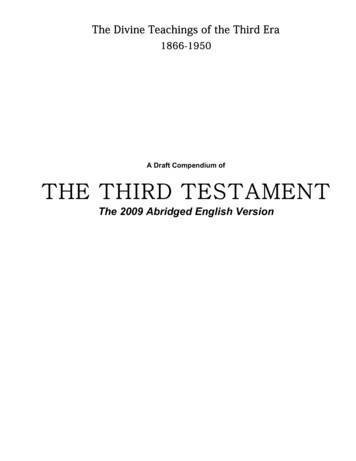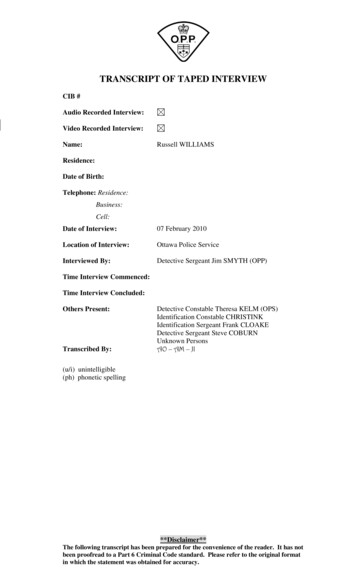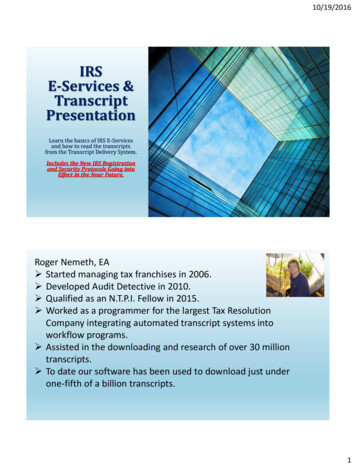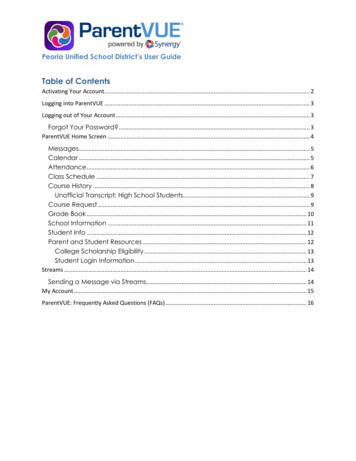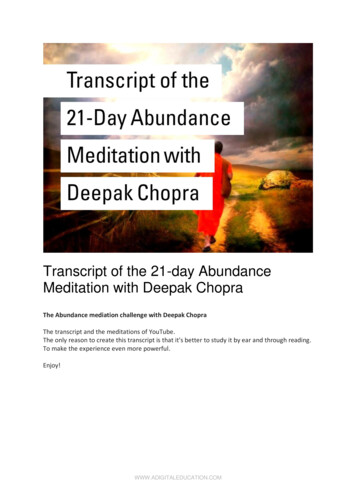
Transcription
ABRIDGED TRANSCRIPT“America & Islam After Bush”Dr. Vali NasrCouncil on Foreign RelationsJeffrey GoldbergThe AtlanticDecember 2008MICHAEL CROMARTIE: Professor Nasr is one of the leading scholars on politics andreligion in the Middle East, and his books are cited as the best on the topic, especially hisrecent book, The Shia Revival. We’re delighted, Professor Nasr, that you could be with usthis morning. Thank you for coming.VALI NASR: Good morning, it’s great to be here. For our discussion today, I want raise anumber of issues I think will be important in considering how a new administration mayapproach the thorny issues in the region and how religion fits into those.It goes without saying that two major challenges, or threat areas, face the newadministration. One of them is encapsulated in the Iranian challenge, although beyondthe nuclear issue we have very little grasp of what that actually means. I would like todelve much more into that. The second challenge revolves around the question of alQaeda, which we know a lot more about and maybe have a better grip on.A key issue that has bedeviled American foreign policy and is a challenge for the newadministration is, first of all, to understand the nature of each of these threats, but moreimportantly to understand how they relate to one another. Are they the same, or are theydifferent? And which is actually more of a threat, and in what regard? How do they impactone another? We have to think about these questions to avoid going around and around,and still find ourselves back to where we were at the beginning. Answering thesequestions are key, not just for American policymakers, but also for the American public,to bring us to a level of understanding beyond the one that we’re currently at.
ABRIDGED TRANSCRIPT“America & Islam After Bush”Dr. Vali Nasr and Jeffrey Goldberg December 2008The world has changed significantly since 2003, as we know. The Middle East has changedin a very significant way. Part of the problem is we have never really understood we aredealing, post-Iraq, with Middle East 2.0: that there are some fundamental, and in myopinion irreversible, shifts in the balance of power of the region.First, there is a palpable, significant, and, I think for the time being, irreversible shift ofpower and importance from the Levant — the area of Lebanon, Palestine, Israel, Egyptand Syria — to the Persian Gulf and the Afghanistan/Pakistan corridor. The region that for50 years was the basis of our foreign policy — we thought its conflicts mattered most, ouralliances there mattered most — does not matter as much to peace and securityanymore. When the Lebanon war happened in 2006, the country that had most to dowith it was not in the neighborhood. It was Iran. The countries in that neighborhood coulddo nothing to stop the war, and this was attested to by Israel, the United States and theregional powers themselves.Everybody today thinks the Palestinian issue has to be solved because it is a surrogate tosolving a bigger problem, which is somewhere else in the region. Once upon a time weused to think — and some people still do — that the Arab-Israeli conflict is the key tosolving all the problem of the regions: terrorism, al-Qaeda, Iran or Iraq. I don’t believe so.I think the Persian Gulf is the key to solving the Arab-Israeli issue. All the powers thatmatter — Iran, Saudi Arabia, and even the good news of the region: Dubai, Abu Dhabi, etcetera — are all in the Gulf. And all the conflicts that matter to us — Iraq, Afghanistan andIran — are in the Gulf and then to the east.So the Arab-centeredness of the Muslim Middle East is gone. We haven’t caught up tothat in our foreign policy. The Middle East now is far more Iranian and Pakistani andAfghani in terms of the strategic mental map we have to deal with. Trying to deal with theMiddle East as if we’re in 2002, before the Iraq war, is one of the main reasons why wehaven’t been able to bring the right force to bear on the problems in the region.The second shift, connected to this, is a palpable movement from the Arab world towardIran. The Arab world has declined very clearly in its stature and power; Iran is a risingforce. You don’t have to take my word; just listen to the Iranians and the Arab leaders.You don’t hear the Iranians worried about the Arab world; you don’t hear a single Iranianleader express any kind of anxiety; in fact, in a very patronizing way they constantly say2
ABRIDGED TRANSCRIPT“America & Islam After Bush”Dr. Vali Nasr and Jeffrey Goldberg December 2008to Arab countries, “don’t worry, we’ll take care of you. You don’t need to rely on theUnited States; we’ll protect you.”Then listen to Arab leaders. The first thing every American official hears when he or shearrives in an Arab capital is worry about Iran. It’s clear that the balance of power — and alot of power is a matter of perception — has moved eastward. The center of gravity hasmoved eastward. It’s a problem for us because most of our alliance investments were tothe west, in the Arab world. Now, those alliances have not done for us as much as wehoped they could, even in the Arab-Israeli issue, where they were supposed to be theones providing all the help.The third and connected shift is that after Iraq there is a palpable shift in the religiopolitical sphere from the Sunnis to the Shias, a sect of Islam that has been completelyinvisible to us. We all of a sudden discovered them, but I don’t think we quite understandwhat we discovered and what it means for us going forward. A fourth, related shift is thatmany of the conflicts we are dealing with, in both Iraq and Afghanistan, involve insurgentSunni forces.The losers in America’s battles in this region are not evenly distributed among the actorsI’m mentioning. The Sunni powers, the Arab powers, have clearly lost as a consequenceof our wars of choice and necessity in Afghanistan and Iraq. Iran and its allies and the Shiaforces have clearly gained. So when we look at Iraq and Afghanistan, we’re essentiallyfacing revanchist forces — forces who lost and refuse to accept what has happened andbelieve they can come back. All of these dynamics are now embedded in the powerstructure of the region, namely this Shia-Sunni issue. The Arab-Iranian issue isencapsulated in the Saudi-Iranian rivalry around the Gulf and in Iranian-Arab rivalry overthe future of Lebanon and the Palestinian issue. These conflict-area issues are going tocontinuously reflect those dynamics.Lebanon, for instance, is going to reflect the power play in this region. The winners andlosers in these wars are not only the local people. A larger force has been unleashed sincethe Iraq war. This Iranian-versus-Arab, Shia-versus-Sunni, Persian Gulf powers-versus-theLevant dynamic is going to play itself out. The insurgencies going against the United Statesare also connected to this, because, as I mentioned, they are intent on turning back theclock in the Middle East to before 2003. So these insurgencies will be ongoing until the3
ABRIDGED TRANSCRIPT“America & Islam After Bush”Dr. Vali Nasr and Jeffrey Goldberg December 2008final shape of this region is settled. It’s not just a matter of troop numbers in Iraq andAfghanistan. Again, we’re dealing with something larger going on in this region.Connecting these geo-strategic issues to what’s happened in this region religiously is veryimportant. We talk about Iran and Saudi Arabia as countries in secular terms, but in themental map of Muslims, they also represent two large civilizational blocks within Islam.Namely, Iran stands for Shia power, whether or not it wears it on its sleeve. Saudi Arabiaand the Arab world essentially represent the Sunni face of Islam. In many ways we thinkthere is a single Islamic threat out there, but that’s not the case.There is an intense rivalry between these two sects of Islam, between both the radicalelements of each and the establishment elements of each. This civilizational or cultural orreligious battle within Islam is now very clearly tied to everything that’s happened afterIraq.Therefore it is not going to stop, because it’s not a matter of getting a couple of clerics ina room to say nice things about one another; it’s not an ecumenical exercise. There is ahuge power play associated with this.We all know how Iraq opened this fissure. It ended up being a turning point for a varietyof reasons. First, it is of symbolic value: Post-Saddam Iraq is the first Shia Arab state inhistory. That represents a major turning of the tide. Now, 60 to 65 percent of Iraq is Shia,which means about 80 percent of its Arab population is Shia. In Lebanon, 30 to 40 percentof the population may be Shia, which makes it the single largest community in thecountry. Seventy-five percent of Bahrain is Shia, and 10 percent of Saudi Arabia is Shia,roughly speaking. Shias makes up between 20 and 25 percent of Pakistan, 30 percent ofKuwait, 20 percent of the United Arab Emirates and about 20 percent of Afghanistan. Yetfor so long, when we looked, we didn’t see the Shias, particularly in the Arab world.So where was this invisible population? It was there. What the U.S. did in Iraq was to showa way to reverse this trend; namely, it showed a path to empowerment for the Shia, firstthrough regime change and secondly through elections. The Shias took to elections veryaggressively after Iraq. I remember the very first thing Hezbollah’s television stations saidafter elections in Iraq was, “We want exactly that — one man, one vote — not this4
ABRIDGED TRANSCRIPT“America & Islam After Bush”Dr. Vali Nasr and Jeffrey Goldberg December 2008democracy where at the end of the day the minorities end up ruling.” The Shias in Saudiand the Bahrain said the same thing.So Iraq is symbolically very important. But the process in Iraq broke down; they ended upfighting one another. The fighting was very polarizing because the Sunnis in Iraq and theirsupporters in the Arab world cast the Shias as the cat paw of Iran; they referred tothe Maliki government and its predecessor as Iranian stooges and routinely referred tothem as the Safavid government, referring to the Shia empire that ruled over Iran andsouthern Iraq in the 1500s and 1600s. And the Iranians did invest heavily in creating theseties within Iraq.But it’s not just about Iraq. We should all take heart in the fact that violence has stopped,although I for one don’t believe we’re out of the woods. We have a ceasefire in Iraq; wedon’t have a deal yet. And when you don’t have a deal between fighting factions,ceasefires are, by definition, unstable. So at some point we either have to find a way toconvert the ceasefire into an agreement, or we’ll go back to fighting. There is no two waysabout it. Or we’re going to sit there indefinitely with the same troop numbers or higherto prevent them from fighting. The reason for fighting hasn’t gone away, partially becauseit goes to exactly what I said: The final solution in Iraq will either confirm Iran’sascendance or confirm some kind of Arab restoration.Therefore a lot rides on that final solution. In fact, it’s a singular mistake to think you canhave a deal by having only Iraqis agree to it, because what they agree to will have muchbroader implications for where the power in that region will lie. A final deal in Iraq ismonumental to the Middle East. It will be the deal that decides the shape of the MiddleEast. But we don’t think in those terms; we think extremely narrowly, as if it’s a matter ofgetting two warring factions in the room.As a side note, we should have learned by now from Afghanistan and Iraq that MiddleEastern governments have enormous amounts of patience to wait us out. Just becausewe beat Pakistan out of Afghanistan didn’t mean they agreed to give it up, and, sevenyears later, they are taking it back whether we like it or not. Therefore a deal that doesn’treflect some buy-in from these neighbors is not going to last, and — maybe not next yearor the year after but eventually — we’ll go back to having fighting in Iraq.5
ABRIDGED TRANSCRIPT“America & Islam After Bush”Dr. Vali Nasr and Jeffrey Goldberg December 2008So it’s bigger than Iraq now. It’s become this Shia-Sunni issue because it goes to the heartof who, ultimately, will be the major power in this region. There are areas of conflict inthe region around this issue. Lebanon is very fragile, because the issue in Lebanon isexactly the same. There is a Shia population that believes it is the majority, in the politicalsense; they believe they have 40 percent of the population but only 18 percent of theparliament and none of the executive offices of the state. The commander of the army,the prime ministership and the presidency all go to non-Shias.Here too, the Shia are going after a minority Sunni government, in its mind, along with itsChristian supporters. Similarly, Bahrain is extremely fragile, not just because Iran isinvesting in it, or because it’s the headquarters of the Fifth Fleet, but also because thesetensions are very much there. We see this problem surfacing: Only two months ago theeminent Sunni cleric, popular on al-Jazeera, Yusuf al-Qaradawi, gave a very nasty fatwaagainst the Shias, arguing they are on a binge to convert Sunnis to Shiism. He came undervery severe criticism, and then he refined his arguments, saying he was really referring toIranian Shias.He went to the heart of the matter. He was saying not that the Shias are a threat, but thatIran is a threat. We don’t have a sense of whether any Sunnis are converting to Shiism,although we do hear a lot of rumors of that, particularly after the Lebanese war in 2006.The aura of power is with Shias, and there is now talk of communities merging in Algeria,in Senegal, in Nigeria and in Syria. Even in Saudi Arabia there is talk, including among highsociety, that there are either nominal or real conversions to Shiism going on.For those of you who might not know the difference between Shias and Sunnis, let megive you a quick sense, because we bandy these terms about. Those of you familiar withChristian history can think of the East Church/West Church divide, while at some otherlevels it’s like the Protestant/Catholic divide. It’s a division in Islam that goes back to thevery first century of Islam. It’s very old. Like the Eastern Church and Western Church, Shiasand Sunnis each believe they hold the original orthodoxy. They got it right, the other guysgot it wrong; it’s not that one is the reform of the other.The reason they separated early on probably looks trivial now; namely, they disagreedover who would succeed the prophet Mohammed. The Sunnis said the community would6
ABRIDGED TRANSCRIPT“America & Islam After Bush”Dr. Vali Nasr and Jeffrey Goldberg December 2008choose the best among them, while the Shiites came to believe the charisma of theprophet would go by bloodline through his progeny, which was then his cousin and sonin-law Ali, who’s buried in the shrine of Najaf, and then Ali’s children. Regardless of whereit began, as with all religious divides, the split grew and they developed a very differentsense of history and theology. So their minor separation at the beginning has made theminto very different sects today.It’s true that Shias and Sunnis both read the same Koran. The trouble is they don’t agreeon the interpretation of a single page of it. That’s not unique to Islam, of course; differentchurches approach biblical interpretation very differently. So with Sunnis and Shias youhave different methodologies, different histories and, over time, these have become verydifferent interpretations of Islam. There are basic ways that they differ: for instance, Shiasstand differently in prayer than Sunnis do.The Shias and Sunnis differ on points of law, which is very important because Islam isfundamentally a religion of law, much like, say, Judaism. You’re a Muslim not by faith.You’re a Muslim by practice. It is practice that defines a Muslim and practice is defined bylaw. So your everyday actions are based on law, and law is interpreted by your clericsbased on a set of methods and interpretations. So the everyday life of the Shia is guidedby Shia law.Much of the law is the same as the Sunnis’ but there are points of difference. For instance,Shia law is far more permissive on inheritance to women and that’s why in countries likePakistan the feudal lords all become Shia right before they die because they want to giveinheritance to their daughters, and it’s permissible under Shia law, or much more so thanunder Sunni law. But there are other points of difference in commerce, in criminal law, etcetera.One of the most important differences is that Shia law, like Anglo-Saxon law, is openended. Namely, the clerics, or ayatollahs, continuously interpret the law going forward,whereas Sunni law is much more like French law: It’s canonical; it’s closed. So AyatollahSistani will make new law on a daily basis if he’s asked, much like the Supreme Court,whereas Yusuf Qaradawi or al-Azhar cannot make new law. They don’t have the authorityto make new law. The law is codified. There is no interpretation to create new law.7
ABRIDGED TRANSCRIPT“America & Islam After Bush”Dr. Vali Nasr and Jeffrey Goldberg December 2008So the function of clerics in Shia and Sunni Islam is very different. Ayatollahs hold far moreauthority than Sunni clerics do. Sunni clerics are like your Protestant bishops. Theyminister to the affairs of the community and advise on law whereas as the Shia ayatollahsare more like Catholic bishops or the rabbis in Eastern Europe. They have a very powerfulcommunal relationship with the population, in part because Shias have been a suppressedminority but also because they carry within them a certain religious charisma that Sunniclerics do not.At the popular level, they are very different. As you may have seen in Iraq, Shia believe inthe visitation of shrines. They have a very direct and personal relationship with theirsaints. There are parallels with Catholicism, like the Shrine of the Virgin of Guadalupe inMexico or Fatima in Portugal. Shias visit their shrines and have a sense that they will behealed, or that their prayers will be heard. There is a very direct, immediate andpassionate relationship with these shrines that seems to go above and beyond religion.At a time in the Middle East when religion matters, then what religion you are, bydefinition, must matter. You should put aside the rhetoric of the Arab world that this isall in the mind of the West or that somehow the U.S. did this. I don’t believe that. I’d seenthis long before, particularly after 1979, when Islam became so important to the MiddleEast. It’s impossible that as more and more people practice Islam, whether it’s in Egypt orIran or Pakistan, that the way you practice doesn’t become an issue. Muslims don’tconvert to another religion and become religious like Koreans did. They turn to their ownreligion to become religious and that makes it much more, if you would, engaging.Coming back to the current time period, this is about a game of power. The Shias in theMiddle East are far more numerous than official numbers suggest. Globally Shias areabout 10 to 15 percent of the Muslim world, but about 90 percent of that Shia populationlives in the Middle East, right there between India and Lebanon. In that arc, sectarianaffiliation matters to us.They are not few, but they have not held on to power. Iraq has opened up a discussionabout a power shift, as has the rise of Iran. Iran benefits from the fact that a largepopulation outside of its territory, without necessarily receiving direction from Tehran,benefits from the rise of Iran and therefore will support it and give Iran soft power on the8
ABRIDGED TRANSCRIPT“America & Islam After Bush”Dr. Vali Nasr and Jeffrey Goldberg December 2008streets. By the same token, those who resist Iranian power are very worried about thiscultural extension of Iran outside its boundaries.This game of power, as I said, is likely to play itself out until we know where the ultimatelines will fall. This Shia phenomenon in the Middle East is of extreme importance in thisregion but it’s one that by and large flies under our radar. We still don’t understand itbeyond the narrow sectarian fight in Iraq. I think it is one of the most significant trends inthis region, the other one being the rise of violent al-Qaeda-type Salafism. That one, as Isaid, is all across our headlines. It is easily visible to us, and we at least think weunderstand it.This one we don’t understand in large part because we don’t even see it. Maybe 10 or 15years from now, or further, we’ll look back and say this was the force that shaped thisregion, beyond the immediate headlines we saw. The change in the dynamic in the MiddleEast obviously benefits Iran. For Iran, the glass is half full. For those who have beendownsized, the glass is half empty.Now, Iranians know the Shia-Sunni issue is a problem for them, and that’s exactly whyforces that resist the Iranian rise are investing so much in the sectarian war, whether it’sin South Asia, in Pakistan and Afghanistan, in Iraq, on the airwaves or on the Internet. Inall those places there is a concerted effort to heighten attention to the Shia issue.Ahmadinejad may have started this vitriol against Israel for a variety of reasons but it haspolitical capital for the Iranian government. That’s one of the few reasons why he maystill endure as a politician in Iran, because he addresses this fundamental issue for theIranian power play in the region: to rally people around the region who are not Shia butwho learned after the execution of Saddam and the sectarian war in Iraq to distrust anddislike Shias and who continuously read anti-Shia literature and hear anti-Shia sermonsfrom Riyadh to Beirut to Damascus. The one reason they may accept Iranian leadership isthe Israel issue. So the Iranians, at the same time as they’re benefiting from the Shia card,don’t like to play it. They like it to be implicitly supporting them. But they would like toexplicitly divert the region’s attention to the one issue that brings them together.Therefore there is a method to the Iranian madness over Israel. Let me put it this way:confronting Israel represents the potential for gaining an enormous amount of political9
ABRIDGED TRANSCRIPT“America & Islam After Bush”Dr. Vali Nasr and Jeffrey Goldberg December 2008capital and soft-power for an aspirant Middle Eastern power whose national and religiousidentity is not that of the Arab world. Iran needs a cause to lever in the Arab world. Itneeds a comeback to sectarianism.Look at Iraq. The sectarian vocabulary was not invented by Iraq. It was invented by theother side. In Lebanon, it was not Hezbollah that proclaimed its war on Israel as a Shiapower play. It was the Arab governments who put it that way. It was the Arab clerics whogave it that name. Iranians would like to focus this on Israel. So the two forces arecompeting to define the struggle. Money is going to Salafis because Salafis are the sharpedge of anti-Shiism. You can see that in Afghanistan, Pakistan and around the Arab world.And the Iranians are matching that radicalism with an anti-Israeli radicalism of their own.These two sides are egging one another on, and we, in some ways, are collateral damagehere, because this is essentially a play for the hearts and minds of the Arabs. It’s powerpolitics on the world stage.MR. CROMARTIE: Jeffrey Goldberg is the national correspondent for TheAtlantic magazine. Before that, he was with The New Yorker where he was the MiddleEast correspondent. His 2006 book, Prisoners:A Muslim and a Jew Across the Middle EastDivide, was hailed as one of the best books of the year by the Los Angeles Times, The NewYork Times, The Washington Post and Playboy magazine.JEFFREY GOLDBERG: Thank you, Michael. I thought I would tell a couple of quick storiesabout encounters with very divergent types of Muslim radicals as a way of illustrating thepoints I want to make. The first is about an interview I did in June of 2000 with a personwho’s been in the news the last two weeks. His name is Hafiz Muhammad Saeed, and heis the head of the Lashkar-e-Taiba, the group that’s responsible for the Mumbai massacre.I went to see him in Muridke, outside Lahore, which is the headquarters of Lashkar.Lashkar was founded as a Sunni extremist or Salafist — actually a Takfiri — group. Thegroup was founded with terrestrial aims in mind, the “liberation of Kashmir.” But by 2000,it is apparent in hindsight, the group, like many Salafist extremist groups, was movingaway from mere terrestrial political concerns toward a more cosmological understandingof its role in history.10
ABRIDGED TRANSCRIPT“America & Islam After Bush”Dr. Vali Nasr and Jeffrey Goldberg December 2008He wanted to talk about the role of jihad in Islam. People like Saeed tend to believe jihad— external jihad, not the internal jihad of self-improvement but actual warrior jihad — isalmost the sixth pillar of Islam. As you know, Islam is built on five pillars: charity, Hajj, etcetera. He talked about jihad as a sixth pillar, and he gave me a long lecture about howMuslims don’t understand the proper place of killing in Islamic doctrine.He quite obviously was a Takfiri, and I’ll give you a brief explanation of what that means.There’s Salafism, which is Wahhabism, the Saudi-inspired, overly literal reading of theKoran; it’s a very arid literalism that leads to extremism. Takfirism is like Salafism onsteroids. Takfir means to declare others apostates and one of the many issues thatseparates Takfiris like bin Laden from Salafists, such as many of the people who run SaudiArabia, is the obsession or preoccupation with killing Muslims who aren’t good Muslimsin their eyes. Obviously, the embrace of murder-suicide — which is un-Islamic, against therules of traditional Islam — is another manifestation of Takfirism.We talked about the role of violence in Islam and the role of violence against infidels inparticular. He said, “It’s morally wrong to kill even a non-Muslim unless he’s hurtingIslam.” But as the conversation went on, it became clear his definition of “hurting Islam”was evermore elastic. He explained, “America favors India. The Indians in America havecaptured the minds of the American leaders.” That made me think that in his mind, the“I” in AIPAC is for India, not Israel. He had this very elaborate conspiracy theory aboutthat.We talked about the Islamic justification for the murder of civilians, the civilians of yourenemy, and he said, “In a democracy, you say the people choose their leaders. So thepeople are responsible for the actions of the leaders. Therefore, they are responsible forthe aggression of their leaders.” In other words, the definition of who was a combatant,of who was the enemy, is growing to the point where it can take in children.Then I asked him, finally, “Could you foresee, in any kind of circumstance, a betterrelationship with America?” He said — and this is the really striking part — “our ideas arebetter. If you want to compete with us, we will compete with you. But our ideas arerooted in the truths of God. Therefore, our way will be triumphant. We do not plan to11
ABRIDGED TRANSCRIPT“America & Islam After Bush”Dr. Vali Nasr and Jeffrey Goldberg December 2008attack America with guns to make you see this. But I know that one day, the people of theworld and the people of America will revert to Islam.” There’s a belief that all people areMuslim; we just don’t know it. So it’s not conversion, but reversion. “And then the peopleof America will know the truth of God.”Let me jump ahead two years to a conversation with a very different sort of Muslimradical. It was in the summer of 2002 in Baalbek, in the Bekaa Valley, and I was havinglunch with a member of the Hezbollah Shura Council. The Shura Council is the religiousand clerical elite of Hezbollah. The guy I was eating with was a very, very difficult man. Inthe course of talking to him, I asked him a very naïve question, especially after 9/11; ithad a naïve, very American assumption built into it. I said, “What do you hope to gainafter having a better relationship with the United States of America?” He laughed. Hesaid, “What makes you think we would want to have a better relationship with the UnitedStates of America?” I said, “Well, there are obvious political and material” — maybe notso much anymore — “benefits to having a relationship with the world’s sole remainingsuperpower.” He looked at me as if I had no grasp of the world I was living in. He said,“You just don’t understand. We don’t want to be friends with you; we want to beat you.”So for obvious reasons, I’ve always linked these two conversations in my mind;thematically, they were very similar.I should mention that on Friday at the Saban Forum in Washington, President Bush gavea speech, a summation of all of his accomplishments in the Middle East over the last eightyears. One of the things he said was quite interesting. It sounded very wrong at first andthen not quite so wrong when I thought about it. He made a reference to the gatheringstorm that America was facing in the 1980s, and he said: “The terrorist movement wasgrowing in strength.” I thought, “That’s very typical of the Bush administration,oversimplifying who the enemy is: there is no terrorist movement; there are terroristmovements.” Then I thought back to these two conversations, one with a Sunni extremist,the other with a Shia extremist. And I thought to myself, these men, if they met, wouldbe sworn enemies. These groups are wildly divergent and yet, these two interviews,because of the thematic similarities, stay in my mind.12
ABRIDGED TRANSCRIPT“America & Islam After Bush”Dr. Vali Nasr and Jeffrey Goldberg December 2008A couple of observations I make out of that similarity. One is the utter surprise, from ahistorical perspective, that I
Dr. Vali Nasr and Jeffrey Goldberg December 2008 . 3 . to Arab countries, "don't worry, we'll take care of you. You don't need to rely on the United States; we'll protect you." Then listen to Arab leaders. The first thing every American official hears when he or she arrives in an Arab capital is worry about Iran.

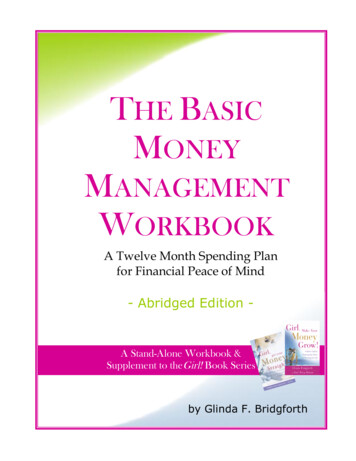
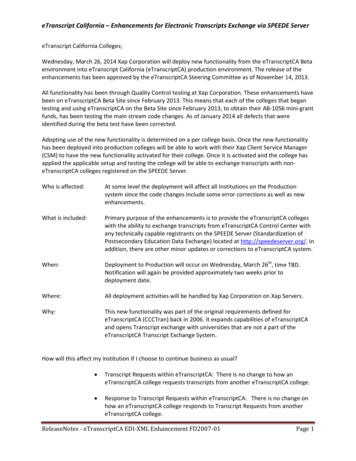
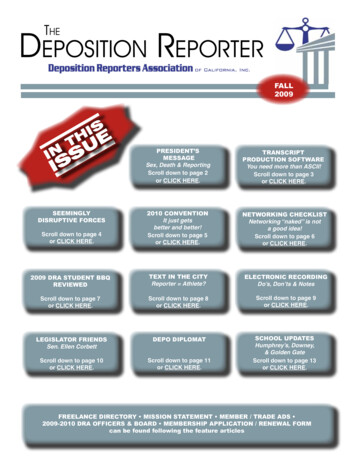
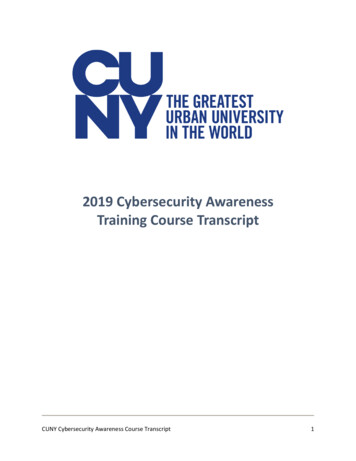
![Letter from Birmingham Jail (1963) [Abridged]](/img/2/1963-mlk-letter-abridged.jpg)
